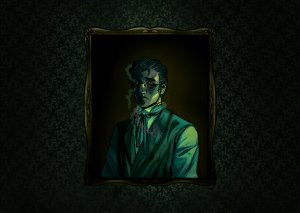When we were initially planning we had no intention of actually showing the Doctor to the player, (apart from his body in the final level). But as we were trying to fill the level 1 scene with objects and furniture, I thought a portrait of him would be interesting for the player to find on the wall.
I looked at a lot of portraits of men from the Victorian era, at their wardrobes, poses, and facial expressions. There’s something very maudlin about Victorian portraits, they all look so serious, in their paintings and photos. Maybe it was something in the air. But either way that sad, I’d-rather-be-anywhere-else look, works well for our Doctor because he really would rather be anywhere else!
I had already drawn him once for the poster of the game, which had influences of bio art and an inhuman green colour palette, and I wanted to replicate that in the portrait because I enjoyed it so much the first time. The fact that the colours are inhuman and that I don’t follow normal human biology in any of the art suggests further that we are dealing with something that isn’t human.

The green pallor of the Doctor’s skin makes him look sickly and uneasy. There is something not quite right about this man, he has hidden secrets he won’t dare share. The right side of his body is obscured in shadow to show that he is a mysterious character we don’t know much about and to hint at his unravelling mental state as he falls more into the throws of paranoia.
After finishing the drawing there wasn’t actually any space to put him on the wall, I figured we might use him for level 2 scenery but when we came to storyboarding, there wasn’t anywhere in level 2 for him to appear either. At this point, I relegated him to the social media account. The Doctor could appear on our Instagram or the website, but you wouldn’t be able to find him in the game. That was until we started to consider how each level would flow into each other.
Between each level, I made a brief silent movie segment that quickly briefs the player on what the doll is going to need them to do to be fixed. Each level starts with the date, the shop bell ringing as the front door opens, and the doctor speaking to the doll about their ailments. The level then ends with the doll leaving. Between levels 1 and 2, the silent movie cutscenes flow right into each other in a clunky way, there wasn’t enough division. That’s when I had the idea to add the portrait in between them, a look into the Doctor’s mental state at the end of each level.
I made a second, more organic and decrepit version of the Doctor for between levels 2 and 3, that uses elements from the poster. These cutscenes are a nod to the novel “The Picture of Dorian Gray” (1895) by Oscar Wilde (1854 – 1900), which includes a portrait of the title character, Dorian Gray, which ages and decays instead of the main character. Keeping him youthful and beautiful for many years until in his unravelling mental state, represented by the painting, he destroys the portrait and the decay of the painting is transferred to him and he dies.
In our game, the Doctor’s grotesque painting does represent his decaying mental state, but also his growing paranoia that the parasites that are growing organic tissue in the dolls has made its way inside him.


Sam Bedson
